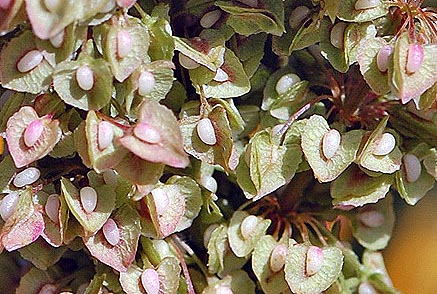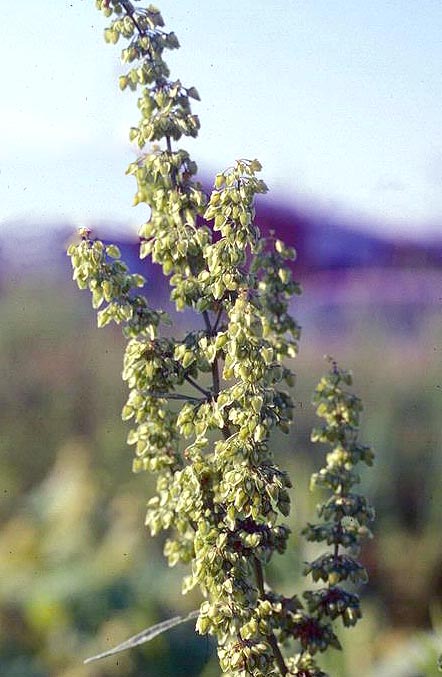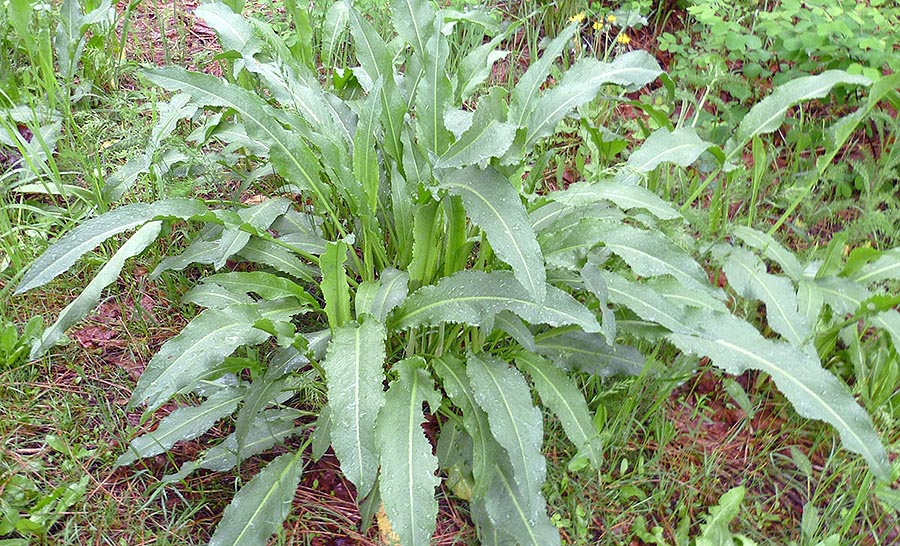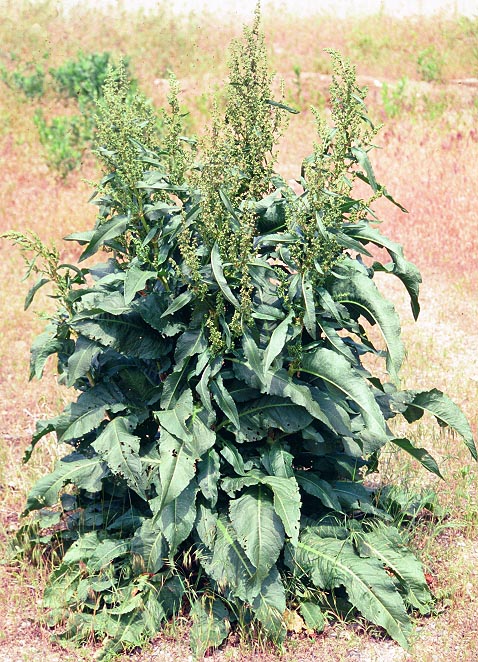Also known as Curly Dock. A tough leafy plant with tall green flower spikes that is grown mostly for use in herbal medicine. However the tough green leaves are very hardy and can tolerate cold conditions, drought, almost any soil type but waterlogged from thick clay to gravel. Very easy to grow. Prefers cooler climates does not do as well in hot humid ones. The roots are used medicinally but the young leaves can be eaten. The green flowers are not really noticeable but many butterflies use the foliage as food for their caterpillars. The tall brown seed heads are loved by many birds and make dramatic winter accents in the garden. Tolerates occasional mowing so is ideal for areas where nothing much else grows, meadows or 'mow it down' gardens. Wildlife don't eat it much unless you count the butterflies.
Description of Yellow Dock (Rumex-crispus).
Tough perennial with thick tap root. Begins as a rosette of basal leaves that can grow to about 12-18 inches (30.5-45.7 cm) long and 8-10 inches (20.3-25.4cm) across. The are long mostly narrow with curly or wavy margins, oblong to lanceolate in shape and dull green in color. They form a mostly circular mounding pile that can reach about 8 inches (20.3 cm) tall. From this arise the flower stalks these have small alternate leaves decreasing in size as they rise to anywhere from 12-48 inches (30.5-121.9 cm) and little branched until the reach the top where they branch into flower stalks. Flowers are on long slender stalks and attached in whorls, they are small no more than 1/8 inch (3mm) long, green with three winged sepals. They are not showy and are only noticeable because of the tall stalk crammed with the green flowers which are wind pollinated so there is no scent or anything to attract insects. Flowers mature into a dry fruit that contains a single seed, Seed heads and stalks turn mid to deep brown when mature and can last in this state until spring as seeds are distributed by the wind. Plant produces a stout taproot with a pale yellow interior.
Growing Yellow Dock (Rumex-crispus) from Seed.
Seeds germinate in light so do not cover. Produces a large tap root so needs to be grown in longer pots and transplanted before tap root develops or sown in place.
Direct sowing. Best done in spring or autumn, but can be done at most times of the year depending on location. In warmer zones (7 and warmer) it can be sown throughout the winter. In cool zones it can be sown throughout the summer.
Starting indoors.
Sow several seeds in small pots seed trays are not recommended as transplanting is more likely to damage roots which can kill the little plants. Using compostable pots of some kind is ideal as they can be directly planted. If not use as tall pots/containers and transplant as soon as roots are visible in the bottom holes. Ensure that roots are a little disturbed as possible. Keep cool do not put on heat pad. For more information on sowing seeds see our
General Growing Instructions.
Sowing time.
When you sow your seed will have an effect on how the plant behaves. If sown in the autumn plants will grow and form a rosette then overwinter and flower in early summer the following year. Those sown in the spring will grow and form a rosette then flower stalks will bloom in late summer and autumn of that year. This may vary depending on the zone as areas with warm winters may have plants flowering in early spring or even winter. Hot areas may have plants go dormant and not flower until autumn.
Location and Care of Yellow Dock (Rumex-crispus).
This is a cooler weather plant so location will depend on your zone. For zones 6a and colder full sun is recommended, for zone 6b-7b some shade from noonday sun would be good, 8 and warmer will need a dappled shade spot where there is plenty of through draft to keep the plants cool.
Curly dock is not fussy about soil type at all it can grow almost anywhere from gravel to thick clay. While it wont tolerate waterlogged soils it can cope with those that get soaked occasionally and drain slowly right up to fast draining gravel.
Its very drought tolerant and hardy withstanding pretty heavy frost before the leaves finally curl up and rest for the winter. It will withstand occasional mowing so its easy to maintain. Ideal for meadows and 'mow it down' gardens
However its environmental conditions will affect its lifespan. Those in more demanding conditions tend to live shorter lives. Some may flower and die in one season while those in good conditions with soil and water can last many years.
If growing with the intentions of harvesting the leaves and seeds a good soil is recommended with organic material and reasonable water. If there is sufficient rainfall don't water it only if there is less then some may be required.
Pollinator and Wildlife with Yellow Dock (Rumex-crispus).
Even though it is wind pollinated so the flowers don't attract insects quite a few butterflies use it as a food source for their larva (caterpillars). Many other insects also feed on the plants and a lot of songbirds and game birds feed on the seeds they seem to be especially loved by turkeys. Mammals don't eat the leaves much since they are often bitter.
Harvesting Yellow Dock (Rumex-crispus).
Roots. Harvest in late autumn throughout the winter, - if it does not freeze solid - and into early spring. Harvesting should be done when the plant is at rest before new green shoots are produced or when only overwintering greenery is present. This ensures that the maximum amount of phytochemicals are present. Digging roots on actively growing plants gives few phytochemicals as they are all being used to grow the plant.
Culinary Uses of Yellow Dock (Rumex-crispus).
Very young leaves can be eaten either raw or cooked. they can also be dried for later use. Use in salads as a potherb or added to cooked dishes. Young leaves are mildly bitter but very rich in vitamins. Older leaves may have more vitamins and possibly minerals but are tough and very bitter.
Stems can be pealed and the central portion cooked and eaten.
Seeds can be ground into flour or roasted as a coffee substitute (a poor one).
Medical uses of Yellow Dock (Rumex-crispus).
The roots have a long history of usage most commonly as a laxative that is milder than rhubarb so is ideal for treating mild constipation. Depending on the dosage it can either cause (large dose) or relieve (small dose) diarrhea but the harvest time of the root will also be a factor as this will determine the relative concentrations of specific phytochemicals mostly tannins which are astringent and anthraquinones which are laxative. It is also used to treat constipation, diarrhea, piles, bleeding of the lungs, various blood complaints and chronic skin diseases.
The roots can also be mashed into a poultice or dried and powdered for dusting on various skin conditions such as wounds, ulcers, sores and with some success on skin cancers.
While the leaves and seeds can also be used they don't have the same concentrations of phytochemicals as the dormant roots do.
Folk remedies insist that rubbing a dock leaf on stinging nettle stings will quickly relive the pain and itching, I have never found this to be a successful
Caution. The plants contain fairly high levels of oxalic acid accounting for some of the bitter flavour. This is perfectly safe in smaller quantities but should not be consumed in large amounts. It should also be avoided by those prone to kidney stones, rheumatism, arthritis, gout, or hyperacidity as well as those who are pregnant or breast feeding.
Other uses of Yellow Dock (Rumex-crispus).
Dye. Dark green - brown, yellow and grey dyes can be obtained from the roots and apparently don't need a mordant.
Compost activator. the whole plant when flowering is dried and powdered then added to compost to encourage bacterial activity.
Flower arrangements. The dried fruit stalks make excellent additions to dried flower arrangements.
Other names.
Acedera, Amalvelas, Broad-Leaved Dock, Chukkah, Curled Dock, Curly Dock, Field Sorrel, Herbe à Cochons, Lengua de Vaca, Narrow Dock, Oseille Crépue, Parelle Sauvage, Patience Crépue, Romaza, Rumex, Rumex crispus, Rumex obstusifolius, Sheep Sorrel, Sour Dock, Yellowdock, Garden Patience










